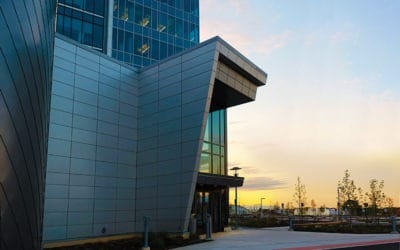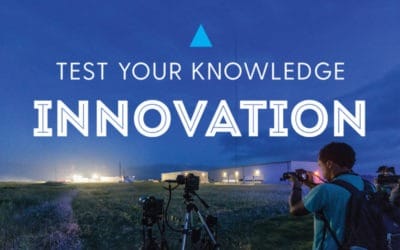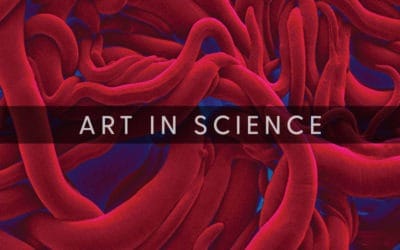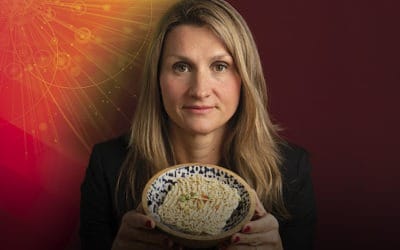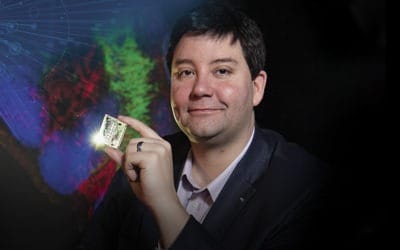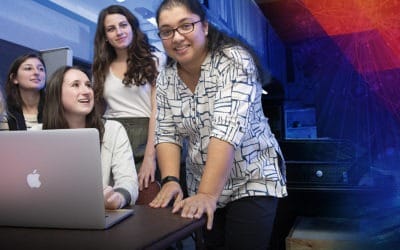
DISRUPTORS
EXPANDING OUR WORLD VIEW
French explorer Jacques Cousteau described scientists as curious individuals who are “looking through a keyhole, the keyhole of nature, trying to know what’s going on.” Discovering the inner workings of the ocean, which spans more than 70% of the Earth’s surface, however, can be a challenge. UD researchers are at the forefront in developing tools and techniques that enable underwater robotic systems, which can go where
humans can’t, to reveal new details about our watery world.
UD GAME CHANGERS
These co-founders of the Robotic Discovery Laboratories in UD’s College of Earth, Ocean and Environment manage a growing robotics fleet for use on land, in air and under the sea. They explore questions along the coast, at the poles and in deep regions of the ocean. For more information, visit ceoe.
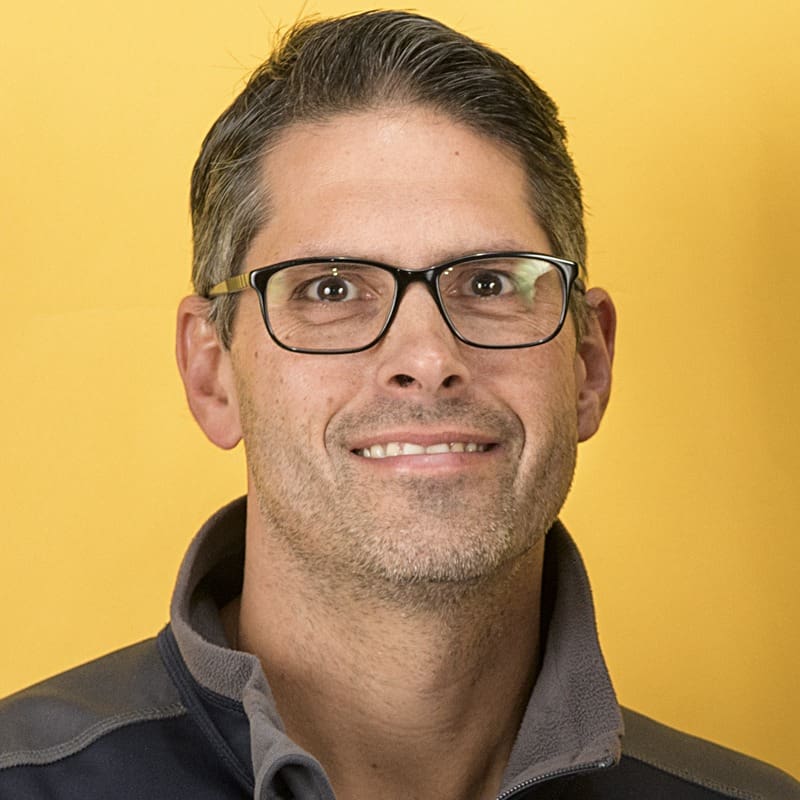
Matt Oliver
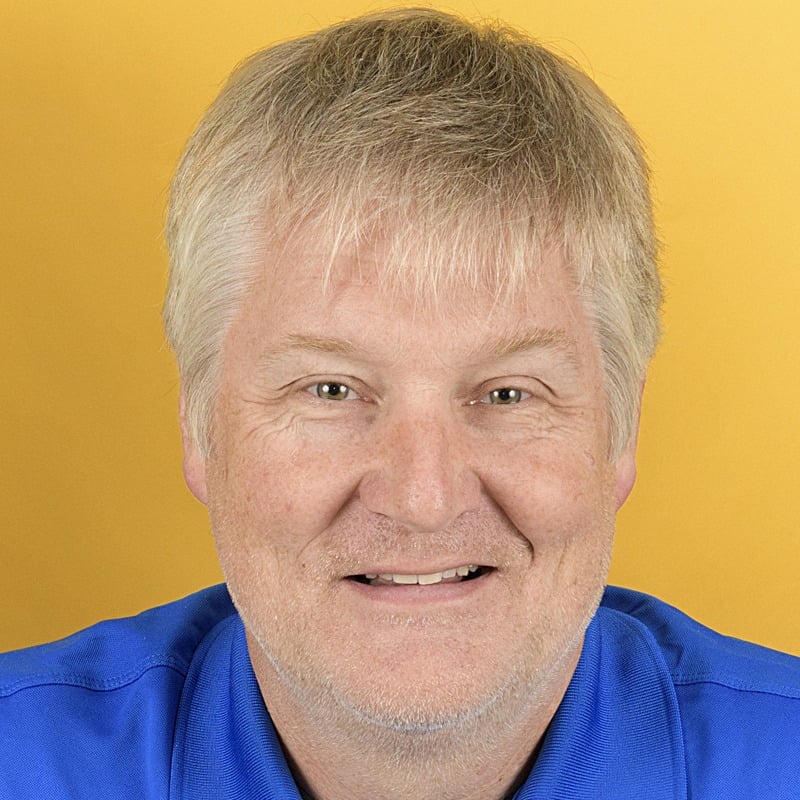
Mark Moline
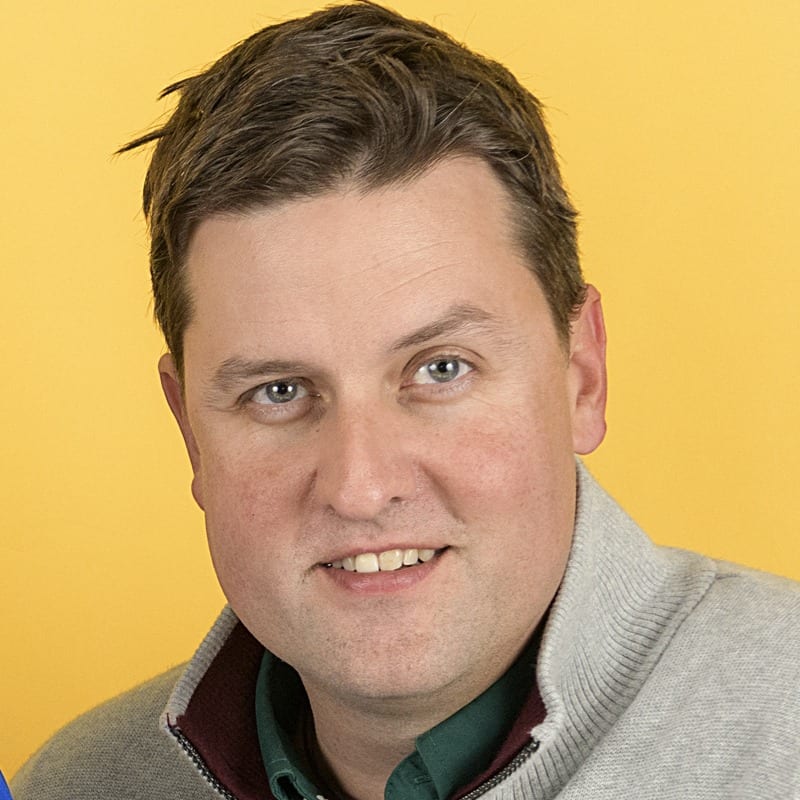
Art Trembanis

Question:
What do you study, and what led you into this field?
Answer:
I study how the ocean environment shapes the distribution of marine organisms. We work on all scales of organisms, from the microscopic to the charismatic. If you’ve ever wondered why you see a species at a particular place and time, then you know what I spend my time thinking about! I think these questions help us understand what kind of world we have lived in and what kind of world we can expect given changes in the environment.
I think it is natural to become habituated to the world we live in. It becomes commonplace, even an annoyance, when it gets in the way of our schedules. Plus, I think our culture encourages us to see our world as unimportant, random, there to fulfill our personal needs, or simply as a stock pile of resources. I prefer to think of the world as art, which means I get to ask both what the piece is made of, but also how each species fits into the message from and about the entire piece.
It is hard work to concentrate on these questions in a place like the ocean. So much of it, and the species within it, is beyond our immediate view. That is why I work to develop and use new robotic platforms to be our eyes and ears, to uncover as much of the marine world as possible.
Question:
Did you color outside the lines as a kid?
Answer:
I thought coloring was a silly waste of time when you could be outside riding bikes, looking at bugs or exploring tide pools in the most grand “coloring” of all!
Question:
Can you recount the tipping point—the idea that produced your ‘aha!’ moment?
Answer:
I did not consider myself a student until about the 10th grade. I was kind of a dorky kid. My high school biology teacher, Mr. Feddes, really sparked my interest in biology. I remember devouring the textbook. It seemed to give my outdoor experiences with nature a framework to ask more interesting questions. It was that year I decided I was going to be a scientist.
Question:
Were there many naysayers and how did you navigate that?
Answer:
I like to think of naysayers as one of my biggest assets. They usually have a point of view you haven’t thought of. In the short run they are frustrating, but in the long run I think they make us stronger. Run away from overly protective advice. You were made for adventure. In light of that, we have done some pretty risky but successful experiments in the ocean with robotic ocean gliders. There were plenty of people who said we were never going to be successful. I thank them every day.
Question:
Did anyone in particular inspire you to think differently?
Answer:
“Superstar” scientists and researchers always seemed like they lived on a different planet. They were so venerated that it just seemed useless to try and emulate them. For me, the most influential scientists in my life were my graduate advisors. They were the ones there with me trying to get an instrument to work or trying to make sense of a data set.
Question:
What has been most satisfying about your work? Most terrifying?
Answer:
It is hard to pick just one thing. In my career, I’m amazed that I actually get paid to do the work I do. The most satisfying part is seeing students flourish through adversity in their scientific career. As these students know, keeping track of robots in the ocean can be really nerve-racking. We like to say that it is more dangerous to operate a robot in the ocean than in space. Our missions can last for months and we are constantly worrying about storms, robots colliding with ships, getting stranded on shoals, getting tangled in old nets or getting attacked by sharks (all of which have happened to us). That being said, there is nothing quite like recovering a robot after a long, successful mission.
Question:
What is your favorite problem at the moment?
Answer:
Tough question. Right now, we are trying to figure out how polar ecosystems work in a changing climate. The changes that are occurring in the Antarctic Peninsula have let us try to figure out how marine ecosystems that are not dominated by local human impacts are responding to climate change. It is a great natural laboratory to understand how ecosystems respond to climate change. Robotic systems are really leading the way in this hostile environment and we are happy to be a part of it.
Question:
Does your disruptive side prove challenging at home?
Answer:
Yes. I don’t think I could do this job without an extremely supportive spouse. Long field campaigns leave the responsibility of family life squarely on her shoulders. Some of that has been alleviated, as I can now send robotic platforms all over the world to do the work. However, she still says that my mind is on the robot and not at home.
Question:
Why do you want to keep doing this work?
Answer:
There are two major questions that drive me: How does the ocean work? and What can we do to preserve the ocean? I think it is fair to say that I walk around with a combined sense of wonder and duty with respect to my work. Right now, about half of my projects deal with the first question and the other half deal with the second one. Projects that span both questions are rare but exciting. Seeing a project start as an idea, get developed technologically, be scientifically tested and then be deployed for general use is extremely satisfying.
Question:
What do you study, and what led you into this field?
Answer:
I am an oceanographer by training. One of the challenges I faced early on is understanding how organisms were distributed in the water in relation to each other and the processes that influence their distribution (currents, mixing, light). In order to improve our understanding of aquatic systems, I have spent much of my recent career in the development of sensors and platforms. The intention is to improve sampling efficiency and thus provide better information on the distribution of organisms and their interrelationships.
Question:
Did you color outside the lines as a kid?
Answer:
Yes. I was not much of a conformer as a kid and I was literally disruptive in class. But, constructively, I ended up migrating to projects that were a bit off topic and provided a new perspective.
Question:
Can you recount the tipping point—the idea that produced your ‘aha!’ moment?
Answer:
I have had a number of these moments in my life. Professionally there was a moment when I had an opportunity to work with some engineers who were developing a new autonomous underwater robotic platform. While their mission was largely focused on engineering performance metrics, I saw the power of these systems to better inform us of how the ocean works and to address a host of science questions. This was the basis for my current research direction.
Question:
Were there many naysayers and how did you navigate that?
Answer:
Few in my field listen to naysayers. Instead, most of us are fairly optimistic and convinced of being able to achieve our scientific goals. There have been some reviewers of grants and manuscripts that have expressed doubts about our achieving certain goals, but I have been able to address these concerns. Over time, one builds a track record of achievement and the number of skeptical comments decreases.
Question:
Did anyone in particular inspire you to think differently?
Answer:
I think everyone has a few people in their lives that have inspired them and been true mentors at various levels. There are four people in particular that I can point to as pivotal for me. They helped me develop as a scientist and navigate a career in science and research. Actual people in my life have served me much more than having abstract role models that I have only read about.
Question:
What has been most satisfying about your work? Most terrifying?
Answer:
The most satisfying aspect of my work is the people that I have worked with and who have kept me learning all of these years. They have allowed me to make connections and to generate ideas that would have been nearly impossible had I been trying to do these things in a vacuum. I have been in some dicey situations, but I’ve learned that the first thing you don’t do is get scared and panic. Keeping a level head, even when faced with threatening situations, ensures that you have a good chance to get out of that situation.
Question:
What is your favorite problem at the moment?
Answer:
Recently, I have been working with bioacoustics of the ocean, or how how living organisms produce sound and communicate. I find the complexity of animal behavior fascinating and I want to do more work in this area.
Question:
Does your disruptive side prove challenging at home?
Answer:
As a kid, yes. I had very patient parents who gave me a lot of latitude. As an adult, I am fortunate to have a spouse that balances some of that disruptive nature.
Question:
Why do you want to keep doing this work?
Answer:
Discovery, finding answers, shared experience with teams of talented people and being able to share my experiences with others.
Question:
What do you study, and what led you into this field?
Answer:
I study how the beaches and seafloor environment change in response to things like storms and ways to use robotic systems to help us find and map natural and human artifacts below the water. In high school I had a chance to participate in a four-year marine science program. In my senior year, I built a fiber optic meter to test the turbidity (or cloudiness) of water. This really cemented my love of both marine science and tinkering. I went on to study geology and oceanography. Afterward, I worked with a company making underwater robots, which brought me full circle to what I had done in high school, blending science and new technology.
Question:
Did you color outside the lines as a kid?
Answer:
I’ve always enjoyed coloring. It is actually one of the areas in my life where I tend to stay within the lines. Maybe it is some form of auto balance. I’m really somewhat OCD about staying within the lines when it comes to coloring. Go figure.
Question:
Can you recount the tipping point—the idea that produced your ‘aha!’ moment?
Answer:
Popular culture tends to portray science as being marked by these ‘aha’ light bulb moments, but the reality is that far more of it is driven forward by mundane moments, negative findings and times of “Hmm, what’s going on there?” or “Why didn’t that work out the way I expected?” Looking back, there have been a variety of tipping point or realization moments where I have learned what I don’t want to do (my short stint in petroleum geology, for example) and where I have confirmed my path, such as seeing how efficient and effective robots can be in conducting repetitive sampling of the environment, which reaffirmed my commitment to the program I’ve conducted.
Question:
Were there many naysayers and how did you navigate that?
Answer:
It’s not so much that one encounters or is brought down by naysayers, as it is about having enough desire and drive to push past your own doubts and uncertainties. Oftentimes, I find myself being more motivated when someone says “that won’t work” or “that can’t be done” because it becomes a challenge. To navigate through the setbacks and challenges one has to persevere. A major setback early in my academic career was the loss of my first robot. Some suggested maybe going back to more traditional approaches would be a better strategy, but I knew we could learn from our missteps and help make the systems better. That has made all the difference.
Question:
Did anyone in particular inspire you to think differently?
Answer:
I have been inspired by pioneers like Dr. Robert Ballard who found the Titanic and Dr. Silvia Earle, an amazing trailblazer for scientific diving. I have been lucky to have been encouraged and mentored by amazing teachers from elementary school (Art Kelstrup) to high school (Ron Nilsen) to college (Dr. Orrin Pilkey) and grad school (Dr. Don Wright), each of whom guided and challenged and encouraged me to strive and dare and fail and get back up again, time and time again.
Question:
What has been most satisfying about your work? Most terrifying?
Answer:
The most satisfying thing is seeing students, especially undergrads and grads, develop and wrestle with new ideas and skill sets and establish confidence and new insights about our marine environment. Administrative duties make it hard to spend as much time in the lab or the field as I would like, but it is really a pleasure to help kickstart students and watch them take flight. One of the most terrifying and simultaneously satisfying things about my work is taking students on study abroad trips to places they haven’t been and watching them learn that they are part of a larger world and global community.
Question:
What is your favorite problem at the moment?
Answer:
My favorite problem is trying to fill in the blank spots on the map. And, developing and utilizing robots to help us map and preserve our watery world.
Question:
Does your disruptive side prove challenging at home?
Answer:
Yes, at times it does. Sometimes I have to remind myself not to always problem solve a situation or to immediately conceive of some tech solution to a problem. There is an obsessive doggedness that comes with being disruptive. Sometimes that leads to me tinkering in the basement when I need to be helping with family chores, or to drifting off from a conversation while I think about a challenge that I am trying to solve.
Question:
Why do you want to keep doing this work?
Answer:
What keeps me going is wanting to be part of the next adventure and discovery. We are in an amazing, exciting time when autonomous systems in the air, on the land and below the sea surface are helping us explore parts of our planet that have never been seen.
MORE STORIES
From the Vice President for Research, Scholarship and Innovation
A disruptor prevents things from proceeding as usual. But that’s not always bad. In research and education, we’re always turning ideas and methods on their ear in the quest to learn something new…
Innovation In Motion
UD researchers partner with Reebok to build a “smart” sports bra — a sports bra engineered to actually do its job!
Disruptors
This issue of the University of Delaware Research magazine puts new faces on this idea of disruption, highlighting the innovative way our researchers are tackling complex problems. Learn about their work and what drives them and how the disruption they cause can produce real benefit for our world.
Bright Star
UD’s Science, Technology and Advanced Research (STAR) Campus is shining ever brighter with the nationally recognized Tower at STAR.
Test Your Knowledge: Innovation
As a growing research institution, the University of Delaware is a place where you’ll find new ideas constantly sparking solutions to challenges once deemed impossible.The wonder of innovation is all around us, but what do you really know about it? Try your hand at these questions.
Art In Science
Now in its fourth year, this annual exhibit offers a captivating glimpse into a vast world of discovery at the University of Delaware.
The Baltimore Collection
Something truly special emerged from a box that no one expected until Julie McGee, associate professor of Africana Studies and Art History, and her University of Delaware students got their hands on the 53 photographs inside.
Disruptors: Probing the Power of Paradox
A professor of management at UD’s Lerner College of Business and Economics, Wendy Smith focuses on how leaders and teams can effectively respond to contradictory agendas.
Disruptors: Defending Equal Access to Food
How does a new supermarket impact people who live nearby? Can healthy options be found in the little store down the street? These are questions that Allison Karpyn ponders regularly.
Disruptors: Cracking a Cell’s Secret Code
Jason Gleghorn has held a variety of jobs since college—teacher, firefighter, medic, engineer. Today, he’s an interpreter of sorts, too, deciphering the language that cells use to communicate in hopes of advancing new treatments for congenital birth defects, pediatric diseases and more.
Disruptors: Making Our Way
Professor of Africana studies at UD and an ordained elder in the African Methodist Episcopal Church, Monica A. Coleman focuses on the role of faith in addressing critical social and philosophical issues.
Disruptors: Moving Forward with Autism
With skills in physical therapy, behavioral neuroscience and biomechanics, Anjana Bhat brings expansive expertise to her work developing creative therapies for those living with autism spectrum disorders.
Disruptors: Harnessing Beneficial Microbes
So, what do a virologist, botanist and soil physicist have in common? This team from UD’s College of Agriculture and Natural Resources is leveraging their collective expertise to ensure that our food supply is safe and abundant, now and in the future.
Honors
UD researchers have been recognized recently by the National Institutes of Health, American Political Science Association, TED Fellows program, National Science Foundation, National Academy of Inventors and the Gates Cambridge Scholarship program.
News Briefs
Check out some recent developments, from the launching of major research programs to address environmental and health issues in the First State, to the preservation of a pair of 1909 mittens with a hallowed history.
CONTACT
Tracey Bryant
Senior Director, Research Communications
Email: tbryant@UDel.Edu
SUBSCRIBE & CONNECT
The University of Delaware Research magazine showcases the discoveries, inventions and excellence of UD’s faculty, staff and students. Sign up for a free subscription.






